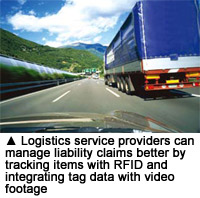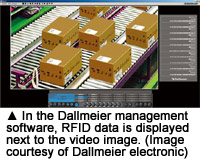The connectivity of RFID and the clarity of video came together in a breakthrough logistics solution created by Dallmeier and RFID provider initPRO.
The connectivity of RFID and the clarity of video came together in a breakthrough logistics solution created by Dallmeier and RFID provider initPRO.
The registration of a filled supermarket trolley at the checkout via RFID transponders — without customers placing all items on the conveyor belt — is still a long way off. The idea of integrating RFID data with video images has become a reality for the first time. This application has been made possible through a partnership between Dallmeier and initPRO. The two companies collaborated within the Network for Innovative Logistics (NIL).
NIL's goal is to provide comprehensive IT logistics solutions and services for manufacturing, warehousing and transportation. The initiative is sponsored by the Federal Ministry of Economics and Technology in Germany. Seven companies, as well as the University of Regensburg and the Regensburg University of Applied Sciences, pool their logistics competence to develop new solutions and innovative products.
As part of the NIL project, Dallmeier and initPRO worked on the integration of RFID data onto video images. RFID makes it possible to transmit data via radio waves, contact-free and without intervisibility. At the core of this technology is a RFID transponder, also known as RFID tag, which consists of a chip and antenna. The antenna absorbs energy from electromagnetic waves and activates the chip, to transmit the data stored on the chip back to the RFID reader.
The developmental work conducted by initPRO relied on already existing documented interfaces by Dallmeier. Dallmeier's experience in video surveillance, as well as initPRO's RFID know-how, was incorporated into the work.
Armin Biersack, who was in charge of the project at Dallmeier, was satisfied. "We have worked together very closely and so, together, we were able to create a solution that can be practically used in a variety of applications," he said.
 For the first time, data transmitted by the RFID tag — such as date, time or serial number — can be integrated into the video image. For this purpose, the RFID reader sends data to the Dallmeier video recorder through an Ethernet connection. The data is then displayed within the management software, either in or next to the video image.
For the first time, data transmitted by the RFID tag — such as date, time or serial number — can be integrated into the video image. For this purpose, the RFID reader sends data to the Dallmeier video recorder through an Ethernet connection. The data is then displayed within the management software, either in or next to the video image.
An important application for this technology is the documentation of the transfer of risk with logistics service providers. To monitor for liability stemming from transport damages or losses, the flow of goods is completely documented through the logistics center — up to when the goods are handed over to the parcel shipment company or the forwarding agent. All parcels are scanned when they come in and when they go out. Additionally, they are captured by a high-resolution color camera. The registered process data is saved by the digital recording system, together with the image data, to ensure that images and parcel data can be matched later.
"Meanwhile, the scanning of the goods is more and more frequently expanded by RFID technology," said Norbert Jungbauer, MD at initPRO. "This saves time as the goods no longer have to be registered manually, but can be booked automatically and in seconds by reading devices. Therefore, it is important to be able to also integrate RFID data into the video images, so that parcels and whole pallets can be conclusively identified in the future."
The technology is used wherever there is stock rotation. Applications besides logistics include retail or manufacturing.
 Beyond that, there are many uses for smart cards. Once RFID tags are integrated with ID cards or passports, individuals can be greeted with a video image upon entering a building. Likewise, it will be possible to check immediately whether an ID was used fraudulently. Another potential application is compliance with fire regulations, through integrated people counting.
Beyond that, there are many uses for smart cards. Once RFID tags are integrated with ID cards or passports, individuals can be greeted with a video image upon entering a building. Likewise, it will be possible to check immediately whether an ID was used fraudulently. Another potential application is compliance with fire regulations, through integrated people counting.
Dieter Dallmeier, President and CEO of Dallmeier electronic, said, "RFID will be used with increasing frequency. Through the recently created integration, we are already well-equipped for the future and have once again developed a pioneering achievement."